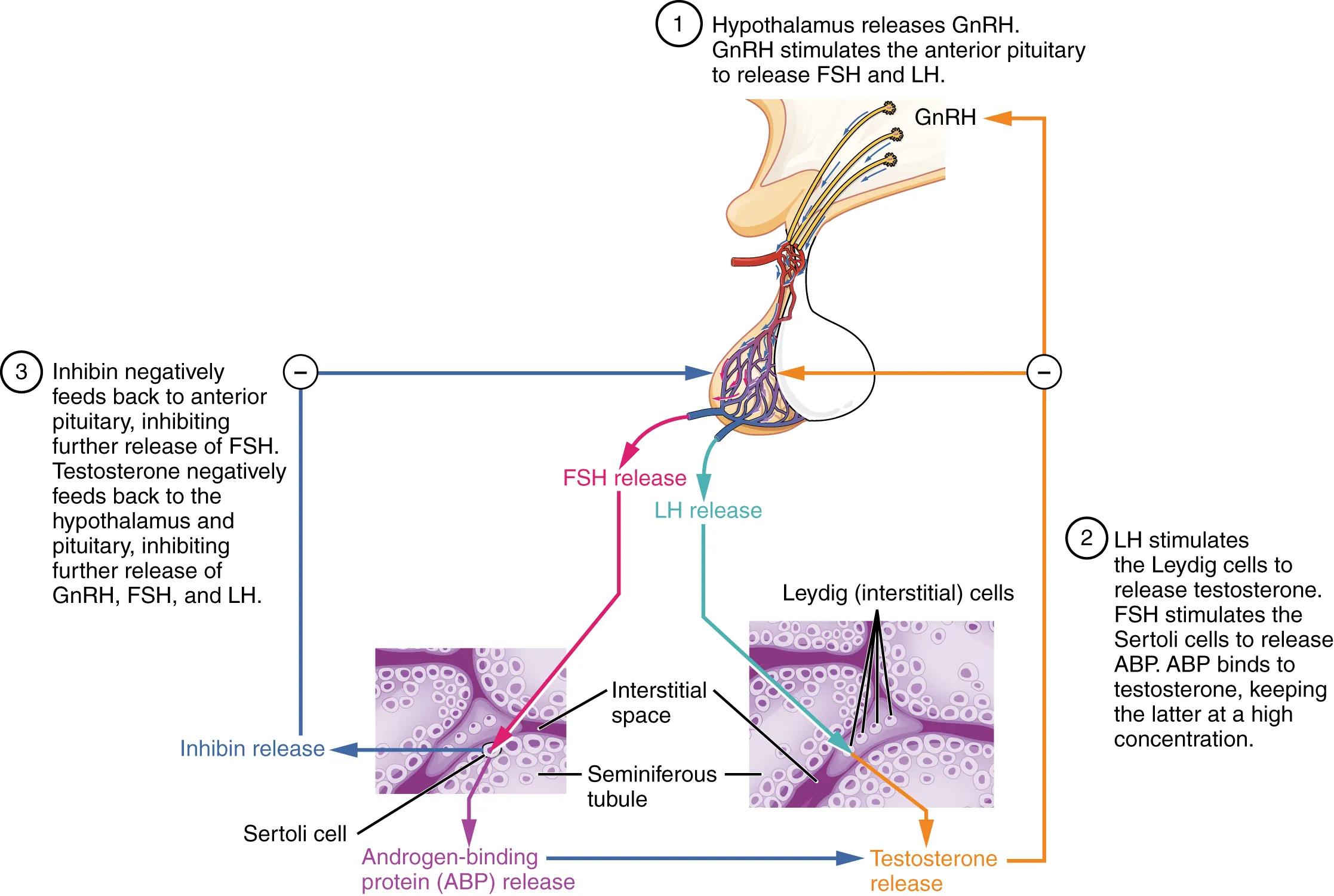The regulation of testosterone production is a finely tuned process vital for male reproductive health and overall well-being. This detailed diagram illustrates the complex feedback loops involving the hypothalamus, pituitary gland, and testes that ensure testosterone levels remain within a healthy range. Delve into the fascinating physiology behind this crucial hormone, exploring the key players and their coordinated actions in maintaining hormonal balance.

Hypothalamus releases GnRH: The hypothalamus, a crucial part of the brain, initiates the process by releasing Gonadotropin-Releasing Hormone (GnRH). This neurohormone acts as the master switch, signaling the pituitary gland to prepare for hormone synthesis and release.
GnRH stimulates the anterior pituitary to release FSH and LH: Upon receiving GnRH, the anterior pituitary gland, located at the base of the brain, responds by releasing two critical gonadotropins: Follicle-Stimulating Hormone (FSH) and Luteinizing Hormone (LH). These hormones are then transported via the bloodstream to the testes, where they exert their specific effects.
LH stimulates the Leydig cells to release testosterone: Luteinizing Hormone (LH) specifically targets the Leydig (interstitial) cells situated within the testes, nestled between the seminiferous tubules. The stimulation by LH prompts these cells to synthesize and release testosterone, the primary male sex hormone.
FSH stimulates the Sertoli cells to release ABP. ABP binds to testosterone, keeping the latter at a high concentration: Follicle-Stimulating Hormone (FSH) acts on the Sertoli cells, also known as nurse cells, located within the seminiferous tubules. This stimulation leads to the release of Androgen-Binding Protein (ABP), which plays a vital role in maintaining a high local concentration of testosterone within the seminiferous tubules, essential for spermatogenesis.
Inhibin negatively feeds back to anterior pituitary, inhibiting further release of FSH: As sperm production progresses, Sertoli cells also release a hormone called inhibin. Inhibin acts as a negative feedback signal directly on the anterior pituitary, specifically reducing the further secretion of FSH. This mechanism helps to prevent overproduction of sperm.
Testosterone negatively feeds back to the hypothalamus and pituitary, inhibiting further release of GnRH, FSH, and LH: When testosterone levels are sufficient, testosterone itself acts as a potent negative feedback signal. It targets both the hypothalamus, reducing GnRH release, and the anterior pituitary, decreasing the secretion of FSH and LH. This comprehensive feedback loop ensures that testosterone production is tightly controlled, preventing excessive hormone levels.
The Hormonal Symphony of Male Reproduction
The male reproductive system relies on a sophisticated hormonal cascade, orchestrated by the brain and executed by the testes. This intricate system ensures the continuous production of sperm and the maintenance of male secondary sexual characteristics. Understanding the interplay between the hypothalamus, pituitary gland, and testes is fundamental to grasping the complexities of male reproductive physiology.
The diagram above beautifully illustrates the core components of this regulatory network. It highlights how signals originate in the brain and travel to the testes, influencing the specialized cells responsible for hormone production. This feedback system is not a simple one-way street but rather a dynamic conversation between these organs, constantly adjusting hormone levels to meet the body’s needs.
Key elements of this regulatory system include:
- The pulsatile release of GnRH from the hypothalamus.
- The differential effects of FSH and LH on distinct testicular cells.
- The crucial role of negative feedback in maintaining hormonal homeostasis.
Disruptions in this delicate balance can lead to various reproductive issues, emphasizing the importance of a well-functioning hypothalamic-pituitary-gonadal (HPG) axis.
Anatomical and Physiological Insights
The regulation of testosterone production is a prime example of a neuroendocrine feedback loop. It begins in the hypothalamus, a region of the brain responsible for many homeostatic functions, including hormone regulation. The hypothalamus releases GnRH in a pulsatile manner, which is crucial for maintaining the sensitivity of the pituitary gland. From there, GnRH travels through a specialized portal system to the anterior pituitary, a gland often referred to as the “master gland” due to its control over many other endocrine glands.
Once stimulated, the anterior pituitary releases FSH and LH. FSH, as its name suggests in females, plays a role in follicle development, but in males, it primarily stimulates the Sertoli cells within the seminiferous tubules. These Sertoli cells are vital for nourishing developing sperm and also produce inhibin. LH, on the other hand, targets the Leydig cells, which are the primary site of testosterone synthesis in the testes. Testosterone, a steroid hormone, then diffuses throughout the body, exerting its wide-ranging effects on muscle mass, bone density, libido, and red blood cell production. The negative feedback mechanisms, involving both inhibin and testosterone, are essential for preventing overstimulation and ensuring that hormone levels remain within a physiological range, highlighting the body’s remarkable ability to self-regulate.
In summary, the regulation of testosterone production is a remarkable example of physiological control, involving a precise interplay between the brain and the testes. This sophisticated system ensures the steady supply of testosterone necessary for male reproductive function and overall health. From the initial signal from the hypothalamus to the intricate feedback mechanisms that prevent overproduction, every step is carefully orchestrated to maintain hormonal balance. A healthy understanding of this system is invaluable for both medical professionals and individuals seeking to comprehend the complexities of the human body.

